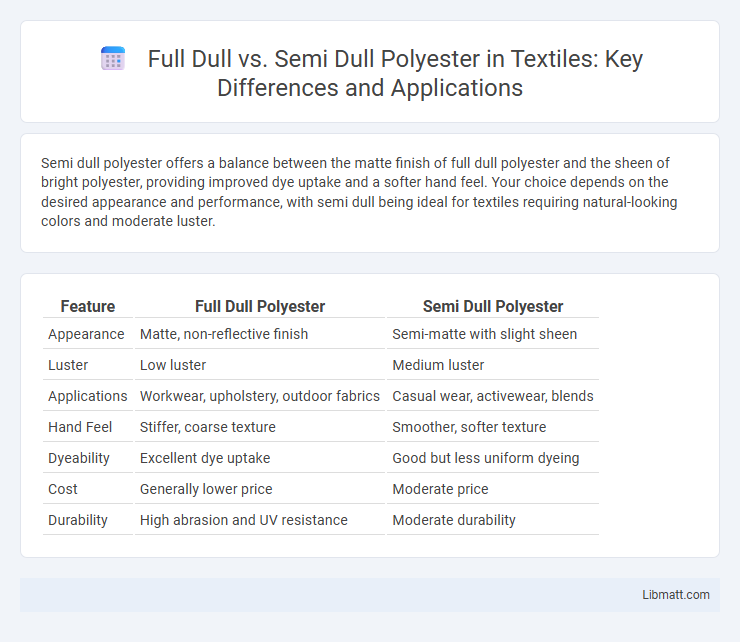Semi dull polyester offers a balance between the matte finish of full dull polyester and the sheen of bright polyester, providing improved dye uptake and a softer hand feel. Your choice depends on the desired appearance and performance, with semi dull being ideal for textiles requiring natural-looking colors and moderate luster.
Table of Comparison
| Feature | Full Dull Polyester | Semi Dull Polyester |
|---|---|---|
| Appearance | Matte, non-reflective finish | Semi-matte with slight sheen |
| Luster | Low luster | Medium luster |
| Applications | Workwear, upholstery, outdoor fabrics | Casual wear, activewear, blends |
| Hand Feel | Stiffer, coarse texture | Smoother, softer texture |
| Dyeability | Excellent dye uptake | Good but less uniform dyeing |
| Cost | Generally lower price | Moderate price |
| Durability | High abrasion and UV resistance | Moderate durability |
Introduction to Full Dull and Semi Dull Polyester
Full Dull and Semi Dull Polyester vary in surface texture and luster, affecting their application in textiles and industrial fabrics. Full Dull Polyester features a matte finish with minimal shine, ideal for apparel requiring a subdued appearance, while Semi Dull Polyester offers a gently muted sheen balancing elegance and functionality. Understanding the differences helps you select the appropriate polyester type for durability, aesthetic preferences, and performance needs.
What is Full Dull Polyester?
Full Dull Polyester is a type of synthetic fiber characterized by its matte, non-reflective finish achieved through specialized polymer additives during manufacturing. This fiber offers enhanced dye retention and a softer hand feel compared to ordinary polyester, making it ideal for apparel requiring a muted, elegant look. You will find Full Dull Polyester commonly used in formal wear, uniforms, and upholstery to provide durability with subdued luster.
What is Semi Dull Polyester?
Semi Dull Polyester refers to a type of polyester fiber characterized by its moderate luster, which falls between the high shine of full bright polyester and the muted appearance of full dull polyester. This fiber combines a balance of aesthetic appeal and functional properties, making it suitable for a variety of textile applications that require both durability and a subtle sheen. Common uses include apparel, upholstery, and industrial fabrics where a less glossy finish is desired without compromising strength or performance.
Key Differences Between Full Dull and Semi Dull Polyester
Full dull polyester exhibits a matte finish with minimal luster, making it ideal for applications requiring a subdued appearance and excellent dye uptake, whereas semi dull polyester offers a slight sheen that balances brightness and softness, enhancing fabric drape and comfort. The key differences include surface texture, with full dull fibers possessing a rougher surface that improves moisture absorption, while semi dull fibers are smoother, contributing to better wrinkle resistance and durability. These variations influence end-use suitability, where full dull polyester is preferred in workwear and upholstery, and semi dull polyester is favored in fashion apparel and home textiles.
Optical Properties: Luster and Appearance
Full dull polyester fibers exhibit minimal luster, resulting in a matte, non-reflective surface ideal for applications requiring subdued appearance and enhanced dye affinity. Semi dull polyester offers moderate luster with a soft sheen that improves fabric brightness and visual appeal while maintaining some light diffusion. The optical differences between full dull and semi dull polyester directly impact textile aesthetics, influencing consumer preference based on fabric sheen and final product usage.
Applications of Full Dull Polyester
Full dull polyester is primarily used in applications requiring a matte and non-glossy finish, such as in upholstery, automotive fabrics, and industrial textiles. Its low sheen and excellent dye absorption make it suitable for home furnishings like curtains, draperies, and carpets, providing a rich and consistent color appearance. Full dull polyester's durability and resistance to pilling enhance its use in workwear and outdoor gear where both aesthetic and functional performance are critical.
Applications of Semi Dull Polyester
Semi dull polyester is widely used in textile applications where a balance between luster and matteness is desired, such as in apparel fabrics, home furnishings, and industrial textiles. Its unique sheen makes it ideal for sportswear, casual clothing, and upholstery, providing both aesthetic appeal and durability. You can also find semi dull polyester in automotive interiors and filtration products, benefiting from its versatility and strength.
Advantages and Disadvantages
Full dull polyester offers a matte appearance with excellent dye uptake and wrinkle resistance, making it ideal for formal wear and upholstery. Semi dull polyester provides a subtle sheen and smoother texture, enhancing fabric drape and elegance but may show wrinkles more easily and be less colorfast. Your choice depends on whether you prioritize durability and easy maintenance or a more luxurious aesthetic with moderate care requirements.
Choosing the Right Polyester for Your Needs
Full dull polyester offers a matte finish with reduced shine, making it ideal for applications requiring a natural, textured look such as upholstery and curtains. Semi dull polyester provides a subtle sheen and smooth surface, suitable for apparel and home textiles where a balance between luster and softness is desired. Selecting the right polyester depends on the end-use, with full dull favored for durability and semi dull chosen for aesthetic appeal and comfort.
Conclusion: Full Dull vs Semi Dull Polyester
Full dull polyester exhibits a matte finish with low luster, providing a soft handfeel and excellent dye affinity, making it ideal for applications requiring a natural, subdued appearance. Semi dull polyester balances shine and softness, offering moderate luster and improved wrinkle resistance suitable for casual and formal wear. Choosing between full dull and semi dull polyester depends on specific fabric aesthetics and performance demands, with full dull favored for muted looks and semi dull for enhanced visual appeal and durability.
Full dull vs Semi dull polyester Infographic

 libmatt.com
libmatt.com